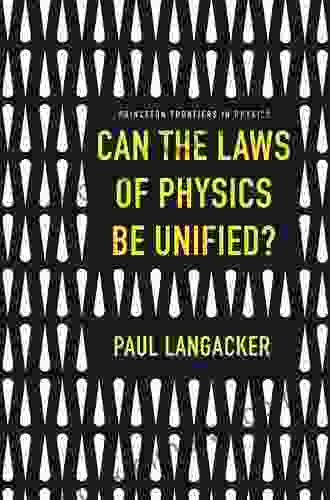Can the Laws of Physics Be Unified?

For centuries, physicists have sought to unify the laws of physics into a single, elegant theory. This quest has led to some of the most profound discoveries in human history, from Newton's laws of motion to Einstein's theory of general relativity.
But despite these advances, the laws of physics remain fragmented. There are four fundamental forces: gravity, electromagnetism, the strong force, and the weak force. Each of these forces is described by its own set of equations, and there is no known way to unify them into a single framework.
4 out of 5
| Language | : | English |
| File size | : | 4282 KB |
| Print length | : | 288 pages |
| Screen Reader | : | Supported |
| X-Ray for textbooks | : | Enabled |
The search for a unified theory of physics is one of the most challenging and exciting frontiers of modern science. In this book, leading physicists explore the latest research on string theory, quantum gravity, and other cutting-edge topics. They provide a comprehensive overview of the current state of the field and discuss the prospects for a unified theory in the future.
The Four Fundamental Forces
The four fundamental forces of nature are:
- Gravity: The force that attracts objects with mass towards each other. Gravity is the weakest of the four fundamental forces, but it is also the most familiar.
- Electromagnetism: The force that attracts or repels electrically charged particles. Electromagnetism is responsible for the interactions between atoms and molecules, and it is the force that powers our electrical devices.
- The weak force: The force that is responsible for radioactive decay. The weak force is the weakest of the four fundamental forces, but it plays an important role in particle physics.
li>The strong force: The force that holds atomic nuclei together. The strong force is the strongest of the four fundamental forces, but it only acts over very short distances.
The Quest for a Unified Theory
The quest for a unified theory of physics has been going on for centuries. In the 17th century, Isaac Newton developed his laws of motion and universal gravitation. These laws provided a unified description of the motion of objects on Earth and in the heavens. However, Newton's laws did not include electromagnetism or the strong and weak forces.
In the 19th century, James Clerk Maxwell developed a unified theory of electromagnetism. Maxwell's equations described the behavior of electric and magnetic fields, and they provided a foundation for the development of modern electronics.
In the 20th century, Albert Einstein developed his theory of general relativity. General relativity provided a unified description of gravity and space-time. However, Einstein's theory did not include electromagnetism or the strong and weak forces.
The search for a unified theory of physics continues today. String theory is one of the most promising candidates for a unified theory. String theory proposes that all of the fundamental forces are different manifestations of a single force that acts on tiny, vibrating strings. However, string theory is still under development, and it is not yet clear whether it will be successful.
The Future of Physics
The search for a unified theory of physics is one of the most challenging and exciting frontiers of modern science. If physicists are able to find a unified theory, it would have profound implications for our understanding of the universe. A unified theory would provide a single, elegant framework for describing all of the forces of nature, and it would open up new possibilities for scientific discovery.
The future of physics is bright. With the continued development of new technologies and the exploration of new frontiers, physicists are poised to make even greater discoveries in the years to come. The search for a unified theory of physics is one of the most important challenges facing physicists today, and it is a challenge that is sure to be met.
4 out of 5
| Language | : | English |
| File size | : | 4282 KB |
| Print length | : | 288 pages |
| Screen Reader | : | Supported |
| X-Ray for textbooks | : | Enabled |
Do you want to contribute by writing guest posts on this blog?
Please contact us and send us a resume of previous articles that you have written.
 Book
Book Novel
Novel Page
Page Chapter
Chapter Text
Text Story
Story Genre
Genre Reader
Reader Library
Library Paperback
Paperback E-book
E-book Magazine
Magazine Newspaper
Newspaper Paragraph
Paragraph Sentence
Sentence Bookmark
Bookmark Shelf
Shelf Glossary
Glossary Bibliography
Bibliography Foreword
Foreword Preface
Preface Synopsis
Synopsis Annotation
Annotation Footnote
Footnote Manuscript
Manuscript Scroll
Scroll Codex
Codex Tome
Tome Bestseller
Bestseller Classics
Classics Library card
Library card Narrative
Narrative Biography
Biography Autobiography
Autobiography Memoir
Memoir Reference
Reference Encyclopedia
Encyclopedia John Scherk
John Scherk John R Dean
John R Dean Julie Murphy
Julie Murphy Stuart Hollingdale
Stuart Hollingdale Judith A Muschla
Judith A Muschla Judy Ferro
Judy Ferro Kurt Dinan
Kurt Dinan Jonathan E Schroeder
Jonathan E Schroeder Paul Newman
Paul Newman Joyce Allene Stone
Joyce Allene Stone Teddy Hitaffer
Teddy Hitaffer Richard Platt
Richard Platt Peter Barnes
Peter Barnes Jordi Bayarri Dolz
Jordi Bayarri Dolz Oskar Cymerman
Oskar Cymerman Nina Revoyr
Nina Revoyr Joseph Jacobs
Joseph Jacobs Pascal Quiry
Pascal Quiry Tim Sale
Tim Sale Bruce Seah
Bruce Seah
Light bulbAdvertise smarter! Our strategic ad space ensures maximum exposure. Reserve your spot today!

 Logan CoxUse the Tool Ugly Awkward Dancing: Unlock Your Inner Confidence, Embrace Your...
Logan CoxUse the Tool Ugly Awkward Dancing: Unlock Your Inner Confidence, Embrace Your... Alexander BlairFollow ·14.5k
Alexander BlairFollow ·14.5k Eugene ScottFollow ·12.1k
Eugene ScottFollow ·12.1k Oscar WildeFollow ·2.1k
Oscar WildeFollow ·2.1k Russell MitchellFollow ·17.2k
Russell MitchellFollow ·17.2k Clayton HayesFollow ·13.3k
Clayton HayesFollow ·13.3k Matt ReedFollow ·4k
Matt ReedFollow ·4k Ryūnosuke AkutagawaFollow ·11.1k
Ryūnosuke AkutagawaFollow ·11.1k Jacob HayesFollow ·17.9k
Jacob HayesFollow ·17.9k

 José Martí
José MartíUnleash the Magic Within: "That's Not a Hippopotamus,...
Step into a Realm Where...

 Cristian Cox
Cristian CoxWhere Is Thumbkin? A Journey Through Beloved Children's...
In the realm of...

 Jason Reed
Jason ReedWitness the Unforgettable Journey of "Royal Tiger Tale":...
: Embark on an extraordinary literary...

 David Baldacci
David BaldacciRicky's Dream Trip to Ancient Greece: An Unforgettable...
Embark on an Epic Journey Get ready...

 Ira Cox
Ira CoxUnleash the Freckled Venom: Embark on an Enchanting...
Dive into the Extraordinary...
4 out of 5
| Language | : | English |
| File size | : | 4282 KB |
| Print length | : | 288 pages |
| Screen Reader | : | Supported |
| X-Ray for textbooks | : | Enabled |












